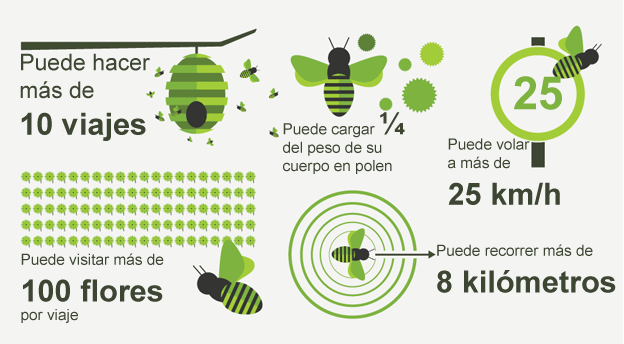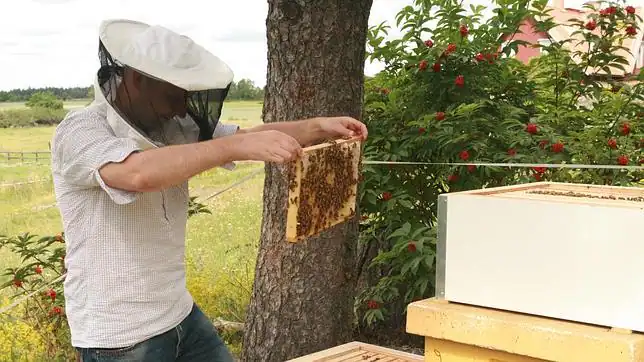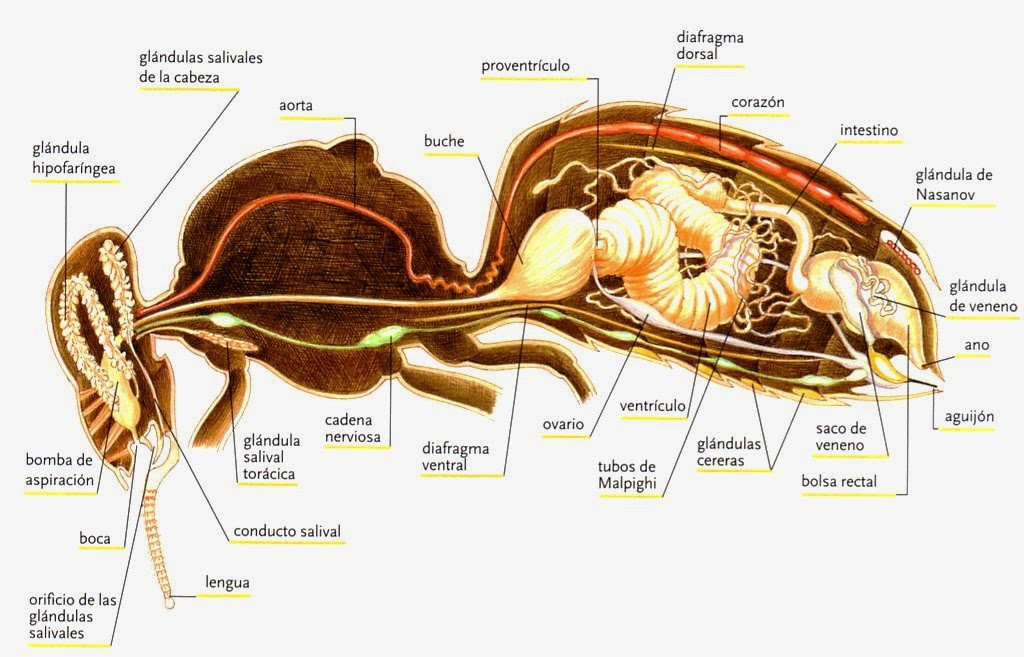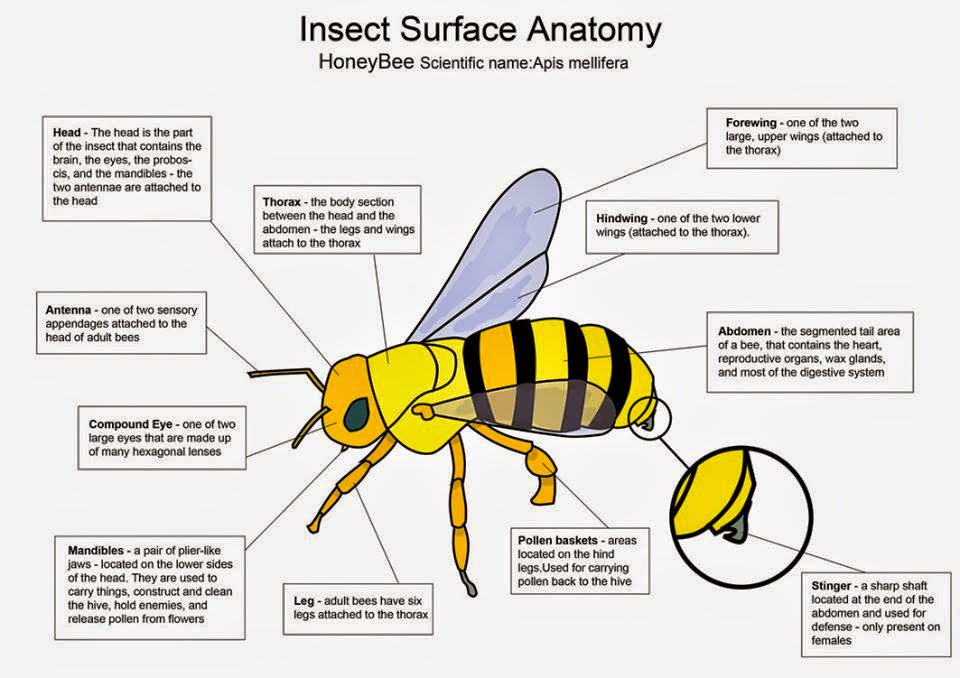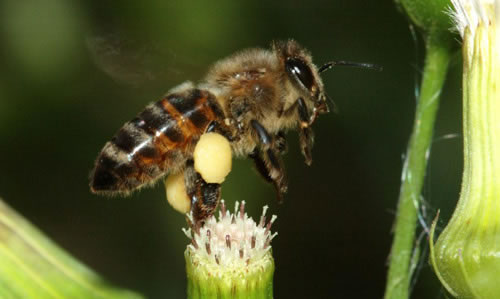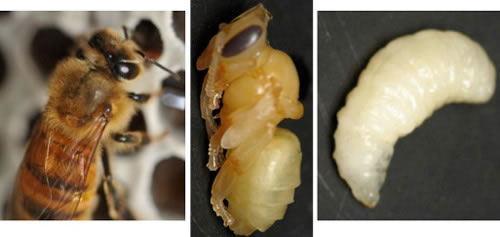The Honey Bee
Common Name: Bee honey, European Bee.
Scientific Name: Apis mellifera and subspecies (Insecta: Hymenoptera: Apidae)
The western honey bee, Apis mellifera, occurs naturally in Europe, Middle East and Africa. This species has been subdivided into at least 20 recognized subspecies (or races), none of which are native to the Americas. However, the subspecies of the Western honey bee have spread widely beyond its natural range due to the economic benefits associated with pollination and honey production.
In Argentina, the bees "European" honey represent a complex of several subspecies crossing between them; Ligustica Apis mellifera, Apis mellifera Carniolan, Apis mellifera mellifera, Apis mellifera causcasia and Apis mellifera Iberian. The introduction of these subspecies to the first American settlers back in 1622. More recently (late 1950), a subspecies of the African honey bee, Apis mellifera scutellata Lepeletier, you might come across European subspecies was introduced in the Americas.
Public interest and participation in the administration of the honey bee (bee) has increased since 2006, when the acute disappearance of worker bees from a colony was described as colony collapse disorder. Since then, research efforts worldwide have focused on improving the health of the colonies and management techniques, and identification of possible causes of colony collapse disorder.
distribution
European races of Apis mellifera have spread widely beyond its natural range. At present, European bees are naturalized on every continent except Antarctica.
description
Like all Hymenoptera, bees have the determination of haplo-diploid sex. Unfertilized eggs (no paternal genetic contribution) become drones (males) and fertilized eggs (both maternal and paternal genetic contribution) develop in females. Female larvae fed the standard diet of pollen, nectar, this food becomes breeding adult workers. Female larvae fed a diet rich in royal jelly, pollen and nectar can become queens.
Worker bees are breeding females. They are smaller in physical size of the three castes and their bodies are specialized for collecting pollen and nectar. Both hind legs of a busy bee have corbicula (pollen basket,. Fig. 1) specially designed to transport large amounts of pollen in the colony. The Worker bees produce wax scales in the lower part of your abdomen. Scales are used to build wax comb in the colony (. Fig. 2). Worker bees have a barbed stinger that struggles with the venom sac from the tip of her abdomen when the bite is deployed on a victim. This results in the death of the worker bee.
The queen bee is the only breeding female in the colony during normal circumstances (some workers can lay eggs unfertilized male in the absence of a queen). Its head and thorax are similar in size to that of the working. However, the queen has a longer and fatter than a working abdomen. The Queen also has a aguijónpero its quills are reduced. Consequently, do not die when you use it.
Drones are male honey bee caste. The head and thorax of the drones are larger than those of the female castes, and his big eyes seem to fly. His abdomen is thick and blunt at the end, that appears sharp in the end as the female castes.
All bees undergo complete metamorphosis. This means they have distinct developmental stages (egg, larva, pupa and adult,. Fig. 3). Typical development time from egg to adult varies by breed. Drones have the longest development (24 days), workers are intermediate (21 days), and queens are faster (15-16 days).
Eggs: Eggs Bees are 1 to 1.5 mm long and look like a small grain of rice. The queen lays eggs in individual hexagonal wax cells in the brood area. After 3 days, the eggs hatch and the larvae emerge. Eggs honey bees can be difficult to see, but their presence indicates a laying queen present in the colony (a very useful tool when inspecting a bee colony administered).
Larvae: In the colony of bees, the larvae are known as "open breeding" because the cells are uncovered. The number of days of the honey bee larva passed as varies by breed (working 6 days Drone 6.5 days Queen 5.5 days). The larvae are white and "C" nestled in the back of their wax cells. When mature larvae are ready to molt into pupae their bodies extending in a vertical position in the cell, and adult workers attending the prepupal larvae rearing cover with a layer of wax.
Pupae: Beneath the layer of wax, honey bee prepupal larvae molt into pupae. The pupae remain in the wax covered until moving into an adult and chew their way out of the cell. The pupae are called "brood," because the cells are capped. As in the larval stage, the pupal development time varies by caste (workers 12 days drone 14.5 days Queen: 8 days).
Adults: adult bees are covered with branched hairs and can be divided into three body regions: head, thorax and abdomen. The main features of the head are the compound eyes and antennae. Two pairs of wings and three pairs of legs that are joined to the thorax. A thin 'waist' is created by a constriction of the second abdominal segment. The most notable feature is the external abdominal stinger. Only female bees have a stinger, it originated in a modified ovipositor.
European bees are not easily discriminated from the present race of African bees in the Americas. But European bees are slightly larger than the African bees. Laboratory personnel used morphometric analysis of wing venation and size of various body parts to differentiate European bees with Africanized honey bees African. Additionally, genetic analysis can distinguish and identify cross between subspecies.
biology
In the bee colony, the work is divided between individuals on the basis of caste and age. The sole purpose of a drone is to mate with a virgin queen from another colony. The queen is the only one that produces eggs in the colony and is responsible for the production of all the descendants of the colony (up to 1,500 eggs / day). The worker bees are called that way because they perform all maintenance of the colony. Each working exclusively performed different tasks in a predictable order based on their age. This is called age-related polytheism. Younger workers care for the brood (eggs, larvae, pupae), while older workers build a hive, handle food stores within the colony and protect the entrance of the colony. Older workers are hunter-gatherer; these are the honey bees that people find more.
The cohesion of the colony of honey bees depends on effective communication. Bees communicate primarily within the colony through chemical signals called pheromones. The workers, drones and queens have several glands that produce pheromones. These pheromones are the queen mandibular pheromone that allows a colony for the presence of their queens, brood pheromones that signal the type of care required by immature bees in the colony, this pheromone communicates the location of the colony for workers who have been displaced in a disturbance of the colony.
One of the most remarkable behaviors of honey bees is their bite. It is a defensive behavior of worker bees to protect the colony. When an intruder is detected in the colony colony, the guard bees release an alarm pheromone that causes a defensive response of the colony. Moreover, when a bee stings, it releases alarm pheromones to attract more bees to sting giving the location of the bite. All worker bees die after stinging, and rarely bite unprovoked European time.
Due to its history of highly social life, colonies of honey bees can be considered superorganisms. This means the entire colony, rather than individual bees, is seen as the biological unit. With this in mind, the bees do not reproduce by producing more individual bees, but rather by producing more colonies. The reproductive process of creating a new colony called swarm.
European Bees usually swarm in the spring and early summer, when pollen and nectar resources are abundant. To begin the process of swarming, 10 to 20 daughters queens are produced by the colony. while the workers sent to explore for a place to establish a new colony (typically a closed cavity, like a hollow tree).
Daughters queens in the original colony, then emerge as adults and struggle until a single queen is still alive, unless a queen emerge before their sisters, in which case it will hunt and kill their unborn sisters. After a short time later maturation, remaining daughter queen leaves the colony to mate with about 15 drones. All mating occurs in the first 2 weeks of life of a queen outside the hive and into the air in drone congregation areas. The queen then stores the collected sperm in her spermatheca for the rest of his life. Once successfully mated, the queen begins to lay eggs daughter, completing the two halves of the swarming process.
The honey bees are adapted to temperate climates, where there is only a short season with generous amounts of pollen and nectar available. For this reason, normally swarm only once a year.The rest of the spring / summer are devoted to the collection and storage of sufficient sources of nectar and pollen to attract deposits of food needed to survive the fall and winter.
This behavior of grabbing resources is what makes European bees are great honey producers. The nectar collected from flowers and transformed into honey through enzymatic processes and dehydration within the colony. At this time, honey has a ceiling above the wax comb where it can stay fresh almost indefinitely, depending on the original source of nectar. Beekeepers and honey hunters can then pick up this honeycomb for human consumption.
Economic Importance
European bees are established in Argentina in the farming system component. In fact, pollination by bees contributes significantly to global food production. Bees pollinate more than 30% of the food we eat, and in the United States estimated that bees pollinate up to $ 15 billion worth of crops each year. In addition to providing pollination, bees also produce other products that people use including honey, pollen, beeswax, royal jelly and propolis.
administration
The management of honey bees is very popular around the world and vary greatly in style and scale. Commercial beekeepers can hold 2,000 or more colonies, while an amateur beekeeper can have just one. The equipment used for the extraction of honey bee colonies is also very diverse.
Pathogens of honey bees and pests have spread worldwide by movement of European bees. In Argentina European bees are subject to a wide range of viral, fungal and bacterial infections. European honeybees are also home to natural pests such as tracheal mites and wax moths, and introduced, such as small hive beetles (a plague of bees Africa) and Varroa (a parasite of the honey bee Asia).
Beekeepers use strategies of integrated pest management to keep the impacts of the many problems associated with pathogenic pests below an acceptable threshold. Some of these control methods include the selection of suitable sites for the hive, supplementary feeding, trapping pests in the colonies, replacement queens, preventive treatments and chemical control.

 Las abejas han desarrollado unos métodos muy sofisticados para encontrar y comunicase con flores ricas en néctar. Cuando una abeja vuela, se carga positivamente, lo que causa una reacción cuando aterriza en la flor, cuya carga es negativa.
Las abejas han desarrollado unos métodos muy sofisticados para encontrar y comunicase con flores ricas en néctar. Cuando una abeja vuela, se carga positivamente, lo que causa una reacción cuando aterriza en la flor, cuya carga es negativa.